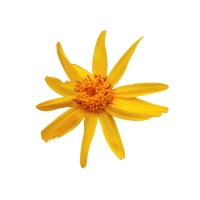 Arnica is a perennial herb often used to prepare Homeopathic remedies. Arnica’s flowers and roots are also used in herbal medicine, typically in remedies applied directly to the skin.
Arnica is a perennial herb often used to prepare Homeopathic remedies. Arnica’s flowers and roots are also used in herbal medicine, typically in remedies applied directly to the skin.
One of the most common uses of arnica is the treatment of wounds, bruises, sunburn and other forms of skin irritation or inflammation. In these cases, an arnica-based gel, cream, ointment, or salve is topically applied to promote healing and soothing of the skin. Arnica gel is also touted as a means of relieving muscle soreness and sprain-related pain.
Homeopathy is a system of healthcare that was developed more than 200 years ago by a German physician. Basically, homeopathy means ‘like cures like.’ You give a little bit of the remedy or chemical to a person who has certain symptoms. In a healthy person [the treatment] would actually cause those symptoms.
The second major principle of homeopathy is the more diluted a substance is, the greater the effectiveness.
Is there scientific proof that arnica works?
David Hobbs, an integrative medicine specialist and licensed acupuncturist at Piedmont Healthcare’s Cancer Wellness Center, says there are studies that have focused on athletic competitions to determine if arnica is effective.
Hobbs says that he would recommend topical homeopathic arnica to his clients who experience frequent bruising or muscle soreness. He also notes, “If somebody needs hard, concrete evidence before they try something, homeopathy is likely going to be outside their comfort zone.”
Dr. Randy Martin: It is important to note that there is insufficient evidence to prove that arnica can effectively treat the conditions we mentioned. In fact, the substance can be harmful, especially if taken orally in large doses. The bottom line: talk to your physician before taking arnica or any other homeopathic remedy. While it may not be harmful in many cases, it is still best to discuss with your doctor to prevent adverse reaction.
Still curious about arnica? Here are a few additional facts:
- Arnica is derived from a European yellow mountain daisy and is sold in topical gels and creams, oral pellets, and massage oil forms.
- Models, fashion designers and athletes alike have touted arnica’s beauty and health benefits, from clearing up facial blemishes to healing post-surgery to improving energy levels.
- It has been used to treat a wide variety of conditions, from chapped lips to insect bites to arthritis.
- Advocates suggest that it stimulates white blood cell activity, thereby increasing circulation, reducing inflammation and reducing healing time.
There is a risk associated with arnica because it contains the toxin helenalin, which, if consumed in large quantities, can be poisonous. It can also cause allergic reactions, digestion problems and is not recommended for women who are pregnant or breast-feeding.”
